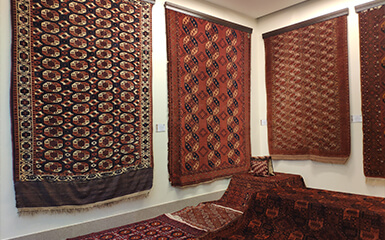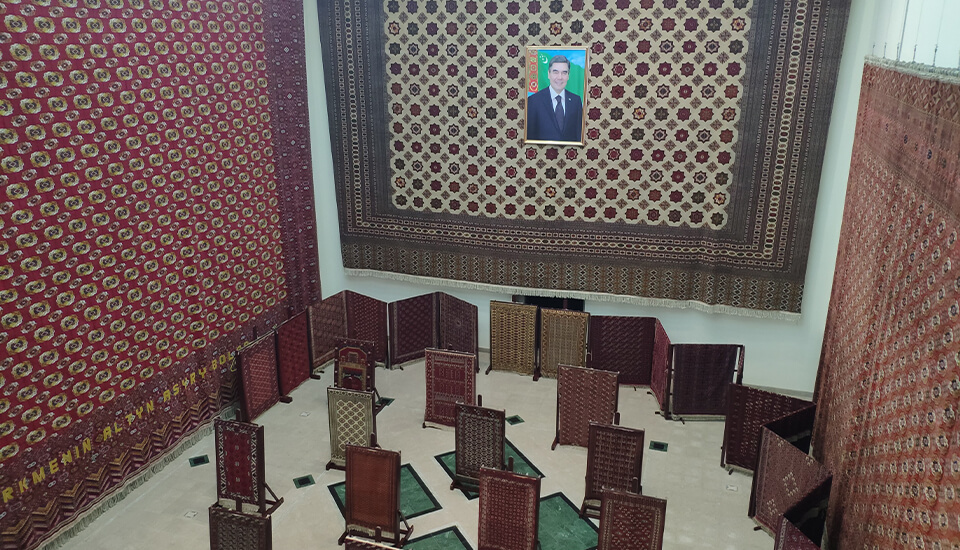Ashgabat
Alem Ferris wheel
State Museum
Fine Arts museum
Wedding Palace
Nisa fortress
Memorial Complex
Ertogrul Gazi Mosque
Neutrality monument
Independence Park
Turkmenbashi Ruhy Mosque
Olympic Village
Ylham Alley
Carpet Museum
Monument of Lenin
Ahal Region
Abivert
Altyn Depe
Annau
Darvaza
Geokdepe
Kowata
Mane baba
Zengi baba
Nedir Shah
Nokhur
Parzdepe
Sarahs baba
Seyit Jemaleddin mosque
Shahrislam
Ulug depe
Mary region
40 cupolas
Akcha Kala
Ancient Merv
Badkhyz
Chilburj
Gebeklytepe
Geok Gumbaz
Gurtly Depe
Kharoba Koshuk
Talkhatan Baba
Yekedeshik
Dashoguz region
Ashyk Aydyn Pir
Devkeshen
Ismamit ata
Kalaly-gyr
Kaplankyr Nature Reserve
Kunya-Urgench
Damla
Balkan region
Dehistan
Yangikala
Awaza
Gozli ata
Kemal ata
Mashat ata
Paraw bibi
Lunar Mountains
Shevlan Baba
Igdy kala
This is no exaggeration. The world's only Turkmen Carpet Museum is located near the intersection of the central avenues. Established in 1994, the museum moved to a new building, which met the peculiarities of rare exhibits, the conditions of their display and storage, in 2009. The museum collection has over 2000 priceless masterpieces of the ancient and modern times, striking in their original beauty, now recognized as invaluable treasure of the world culture.
The Turkmen national art of carpet weaving has originated in the ancient times and attracts tourists and connoisseurs of the world-class artistic values to the country. Moreover, the Turkmen carpet is inscribed on the UNESCO World Cultural Heritage List as an outstanding work of art of the people.
Turkmen Carpet Day traditionally celebrated in Turkmenistan (last Sunday in May) has developed into an apotheosis to the Turkmen carpet and skilful craftswomen who create these magnificent carpets. On the eve of the holiday, the whole country turns into a huge exhibition, and guests from all over the world come to Ashgabat to participate in it and to enjoy the beauty and refinement of the famous carpets. The unique Turkmen Carpet Museum becomes the centre of the celebrations.
In the museum, people can watch a carpet with the highest density in the world – 1 300 000 knots! Almost every exhibit of the museum is unique, including in the Islamic prayer rug called ‘namazlik’ depicting the Muslim holy cities – Mecca and Medina. There are only five such carpets in the world. The second of them is kept in a private collection in London; the third owner was the Russian Emperor Alexander II. Nothing is known about the other two carpets.
Another exhibit that impresses the most demanding tourists is a relief carpet with the image of dragons. In 1948, Abdulla Esgerov and Bostan Geldyeva decided to create a carpet, unique in content and technique and inspired by the beauty of the Seyit Jemaletdin Mosque in Anau (‘House of Beauty’), the portal of which was decorated with the mosaic image of two bright yellow dragons. When the carpet was almost woven, the work was stopped by the catastrophic Ashgabat earthquake, killing both of its creators and destroying the mosque that inspired them. Four years later, the work on the carpet was completed by Bostan's mother. However, the carpet making technique still remains a trade secret, which cannot be revealed for over 70 years.
The works of contemporary craftswomen on the restoring and copying from catalogues and information materials of the 17-19 centuries carpets, available in the collections of the world famous museums, are of great interest of tourists. An exact copy of the Pazyryk carpet created in the 4th century BC and exhibited in the Hermitage, St. Petersburg, is among these works.
Visitors to the museum will also watch the most impressive masterpieces of the Turkmen craftswomen in the 20th century – giant carpets. One of them (a total area of 301 metres2) was inscribed on the Guinness World Records in 2001 as the world's largest handmade carpet.
The first giant carpet called ‘Turkmen kalby’ (‘the Turkmen Soul’) is exhibited in the museum. It was woven in 1941-1942. 36 best carpet weavers worked on the carpet. The carpet size: 1075x1800 cm, total area – 193.5 metres2, density – 252 000 knots per a square metre, about 48 762 000 knots in total, weight – 865 kilogrammes.
The museum displays another giant carpet woven in 1996. It has a total area of 266 metres2 and a weight of 550 kilogrammes. Only one of the giant carpets, created in 1998, was not included in the museum exposition. The giant carpet called ‘President’ (294 metres2, 1 ton 105 kilogrammes) adorns the majestic Ruhyyet Palace nowadays.
The museum exposition includes amazing classical and ornamental carpets, unique double-sided carpets, carpets with landscape pictures and magnificent paintings, and other valuable works of art, including in national fabrics, samples of traditional women's costumes with national embroidery and jewellery.
Our travel company organizes annual group tours dedicated to the Turkmen carpet. Their programmes include a visit to the unique Turkmen Carpet Museum, where people can explore the history of the Turkmen hand-made carpet weaving, watch the masterpieces of national arts, and attend the festive celebrations. Moreover, tourists will have the opportunity to watch how a carpet is made: to observe the painstaking creative work of skilful craftswomen.
And the thing is that people can purchase an authentic handmade Turkmen carpet, highly valued by royal families and celebrities. Thus, beyond the borders of Turkmenistan, it is hardly possible to buy a real Turkmen carpet, known for its beauty, delicate patterns of the stylized images and clear geometric compositions, and for the highest quality. For the guests of the country, a Turkmen carpet represents a work of art consecrated by the centuries-old traditions and the warmth of the Turkmen land. This masterpiece will turn a simple house into a royal palace!


